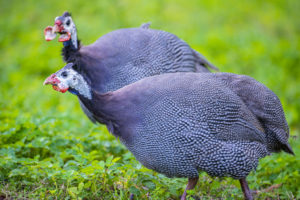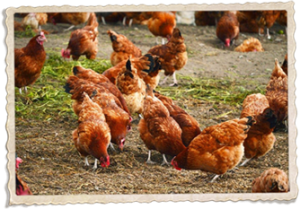Many people who raise backyard chickens are starting to get into raising guinea fowl. There are many benefits to raising guineas—they help protect the rest of the flock, they’re an effective means of pest control, and they provide plenty of meat and eggs.
But, if you’re just starting to raise guinea fowl, you may not be sure where to start. That’s why we’ve created this guide to help you raise guineas.
Shelter and housing
Guineas enjoy to free-range, but they still need shelter to stay safe from the elements. You should always have a shelter that is separate from your chickens’ coop, especially if you have both male guineas and roosters. Forcing chickens and guineas to live under the same roof can cause fighting, so it’s best they have their own coops.
When building a coop for your guinea fowl, make sure they have plenty of room. These birds should have 2 to 3 square feet per bird. You should also provide plenty of absorbent bedding, including wood shavings, chopped haw, or straw. Litter should be kept dry and clean, and perches should be built to allow guineas to roost.
Additionally, while guineas have a good deal of feathers, they still need to be kept warm during the winter. If your coop is unheated, be sure to provide plenty of insulation to keep out both the cold and moisture.
Finally, don’t forget your nest boxes! You can use similar nest boxes as you would for your chickens without much of a problem.
Keets or adults?
Baby guinea fowl, or keets, can be easily purchased from places like Chickens for Backyards. Raising keets into full-grown guineas is especially fun and rewarding.
However, this task can be daunting to some. As such, you can try buying guineas as adults. This will be especially beneficial if you’re purchasing guineas to control ticks and insects around your flock.
No matter if you get keets or adults, though, you’ll want to ensure you create a welcoming and healthy environment. Give your guineas some time to get used to their new surroundings. You’ll want to keep them confined for about a week to prevent them from running away, but make sure they have plenty of company as guineas hate to be alone.
Feeding
Most adult guineas will forage for themselves. They’ll feast on insects, arachnids, weeds, dandelions, worms, slugs, and more. However, it’s important to provide them with plenty of grit to help with digestion. Additionally, they also enjoy scratch feed on the ground, such as wheat, millet grain, or sorghum. Be sure to also provide fresh, clean water at all times.
If your guineas are not foraging, or you’d like to supplement their diet, then they can be fed a typical poultry feed. They’ll need more protein than chickens, so make sure you select feed that is 24% to 26% protein for keets, gradually reducing it to a 16% layer mash by the time they’re eight weeks old.
If you’re looking to purchase guinea fowl for your flock, Chickens for Backyards is here to help. Look through our selection of guineas to get started!

